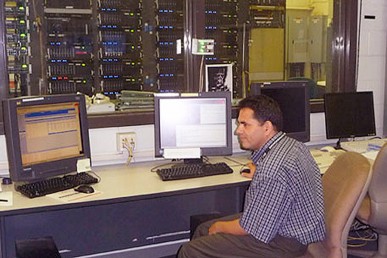Collider reveals sharp change from ‘quark soup’ to atoms
Using the atom-smasher at the U.S. Department of Energy’s Brookhaven National Laboratory and its ability to scan to lower collision energies, scientists have observed a sharp phase transition — different from the smooth change in the early universe — from a “hot soup” of quarks and gluons, into the protons, neutrons and electrons in atoms that are the building blocks of matter.
Their study is published in Physics Review Letters.
Brookhaven’s Relativistic Heavy Ion Collider acts as a time machine, says Yadav Pandit, UIC postdoctoral fellow in physics.
“We can’t go back in time, but we can reproduce the conditions present just after the big-bang and try to understand the evolution of the early universe.”
A familiar phase transition occurs when water is heated to boiling. The water’s temperature rises until it begins to turn into steam. The temperature stops rising as the heat’s energy goes into the change of state from liquid to gas.
Pandit was looking for the signature of that moment — when the energy going in stops producing one effect and goes into producing the phase-change instead.
For more than 30 years physicists have used colliders to look for this sharp phase transition, a so called first-order phase transition, between the quantum plasma of the early universe and the normal matter of atoms and molecules that make up the universe we know, Pandit said.
“This is a very significant observation,” said Olga Evdokimov, UIC associate professor of physics and a principal investigator in UIC’s heavy ion research group. “It addresses one of the central questions of our field.”
Pandit analyzed data on heavy gold nuclei collisions at various energies from Brookhaven’s Relativistic Heavy Ion Collider STAR collaboration, one of two groups of physicists conducting experiments at Brookhaven using huge particle detectors.
He found the signature — a temporary disappearance of a particular kind of particle-flow coming out of the collisions.
“When the collision takes place at an energy close to a first-order phase transition, the expansion and the resulting deflection of the emitted particles is ‘softened,’” Pandit said. Energy that would normally expand the system instead goes into changing the state of matter — “melting” the composite particles, like protons and neutrons, to free the quarks and gluons.
“These results have certainly brought us several steps closer to a complete understanding of the big picture of the phase structure of the nuclear matter,” said David Hofman, UIC professor and head of physics and a principal investigator in UIC’s heavy ion research group.
All members of the STAR collaboration are co-authors of the paper, including the other members of the UIC heavy ion group in addition to Pandit and Hofman: Zhenyu Ye, assistant professor of physics; Yaping Wang, postdoctoral research associate; and graduate students K. Kauder and Z. H. Khan. The work was done at Brookhaven National Laboratory and funded by the Department of Energy’s Office of Science.


